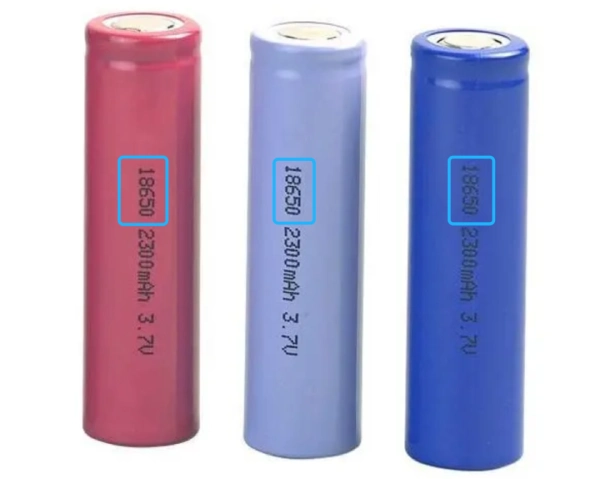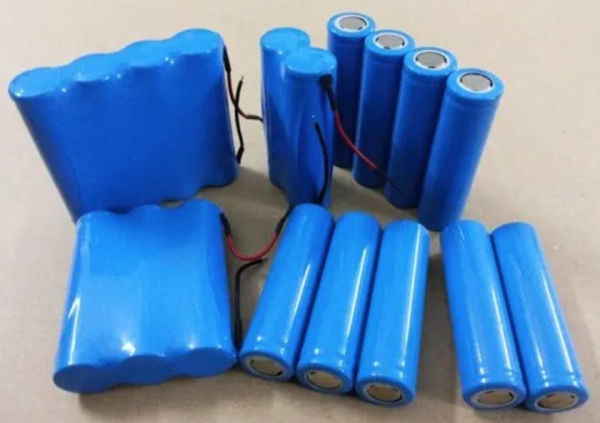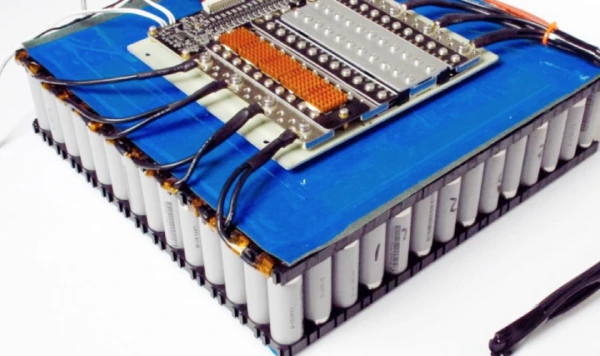Part 1. What is 18650 battery?
1. 18650 battery history

18650 refers to the appearance specification of the battery. It is a standard battery model set by the Japanese SONY company in order to save costs. Among them, 18 means a diameter of 18mm, 65 means a length of 65mm, and 0 means a cylindrical battery. 18650 batteries originally referred to nickel-metal hydride batteries and lithium-ion batteries. Since nickel-metal hydride batteries are less commonly used now, they now mostly refer to lithium-ion batteries.
In contrast, stacked lithium-ion batteries are far from mature. Common ones include rectangular batteries and soft-pack batteries, and even the size, size, and tab position are not uniform. The production processes possessed by many battery manufacturers cannot meet the conditions, and most of them rely on human control. The consistency of the battery is not up to the level of the 18650 battery.
If the consistency of the battery does not meet the requirements, the management of a battery pack formed by a large number of batteries in series and parallel connection will not allow the performance of each battery to be better exerted, and the 18650 battery cell can solve this problem.
18650 battery is the earliest, most mature and stable lithium-ion battery and is widely used in electronic products. Over the years, Japanese manufacturers have accumulated a lot of experience in the production process of 18650 batteries, making the consistency and safety of the produced 18650 batteries reach a very high level.
2. 18650 battery application
In terms of size, the 18650 battery is a type of fixed-size battery designed for industrial applications. It is not consistent with the size of No. 4, No. 5 or AA, AAA batteries in daily life. The 18650 battery is a cylindrical battery with an independent size.
Generally, 18650 batteries are mostly used in industry and rarely used in civilian applications. The common 18650 battery is mostly used in laptop batteries and high-end flashlights.
Part 2. 18650 battery capacity
18650 battery can be divided into three categories according to different materials: 18650 lithium-ion battery, 18650 lithium iron phosphate battery, and 18650 nickel-metal hydride battery (rare).
1.18650 lithium ion battery capacity

The nominal voltage of a single cell of 18650 lithium-ion battery is generally 3.6V or 3.7V; the minimum discharge termination voltage is generally 2.5~2.75V. Common capacities are 1200~3300mAh.
Some lithium battery manufacturers mark the voltage of 18650 lithium-ion battery as 3.7V or 4.2V, which is the same thing. It’s just that the manufacturer’s labeling is different. 3.7V refers to the platform voltage (ie average voltage) of battery discharge during use. And 4.2 volts refers to the voltage when fully charged.
The common rechargeable 18650 lithium battery has a voltage of 3.6 or 3.7V. When fully charged, it is 4.2v. This has little to do with power (capacity). The mainstream capacity of 18650 batteries ranges from 1800mAh to 2600mAh (the capacity of 18650 power batteries is mostly 1200~1600mAh). Mainstream capacities even have capacities above 3500 or 4000mAh.
2. 18650 lithium iron phosphate battery capacity

The voltage of 18650 lithium iron phosphate battery is marked as 3.2V or 3.65V, which is the same thing. It’s just that the manufacturer’s labeling is different. 3.2V refers to the platform voltage (i.e. average voltage) of battery discharge during use, while 3.65V refers to the voltage when fully charged.
The theoretical specific capacity of lithium iron phosphate is 170mAh/g, the discharge platform is 3.4V, and the material energy density is 578Wh/kg. The theoretical specific capacity of lithium manganese phosphate is 171mAh/g, the discharge platform is 4.1V, and the material energy density is 701Wh/kg, which is 21% higher than the former.
In terms of capacity, the capacities of the two materials are basically similar. The only difference is that the latter has a higher discharge voltage platform.
Based on this, the energy density of the battery should be increased by 20%. The lithium iron manganese phosphate battery can naturally reach 156Wh/kg. To be modest, it can indeed reach 150Wh/kg. Judging from the current technical data, the capacity of 18650 lithium iron phosphate battery should be between 1000mAh and 3000mAh.
3.18650 NiMH battery capacity
The voltage of the nickel-metal hydride battery is 1.2V, and the capacity of the aa nickel-metal hydride battery is 2100mAh. It can be estimated that the capacity of the 18650 nickel-metal hydride battery should be around 27mAh.
18650 nickel-metal hydride batteries were initially available on the market, but due to the emergence of 18650 lithium-ion batteries, the disadvantages of nickel-metal hydride batteries were too obvious in terms of application, so they were basically replaced.
Part 3. 18650 maximum capacity
As mentioned earlier, 18650 batteries now mostly refer to lithium-ion batteries. So here we mainly introduce the 18650 lithium-ion battery.
The maximum milliamp-hour capacity of the 18650 lithium battery is still a question worth discussing, so it has always attracted the attention of many practitioners. In recent years, various lithium battery manufacturers in China have improved their technology, and through continuous experimental research and development, their capacity has gradually increased. The large-capacity 18650 lithium battery currently purchased in bulk on the market is 2950mAh.
To maximize the capacity of the 18650 lithium battery, 3500mAh can only be achieved in the laboratory. Because there are still some technical issues that have not been researched out, if you want to mass-produce them, you may have to wait until the technology matures. The capacity of 18650 lithium battery currently sold on the market is 2950mAh. A battery with this capacity is called 3000mAh in the industry.
Panasonic’s 18650 lithium battery reaches 3000mAh (mass production). LG’s 18650 lithium battery can also achieve 3000mAh (mass production). Therefore, the maximum capacity of 18650 battery cells is based on the capacity of mainstream products. If the battery capacity is 2400 mAh, it takes about 10 hours to charge the 18650 lithium battery. The voltage of 18650 lithium battery is 3.7v or 3.2v, and the common capacities are 2000mAh/2600mAh/3000mAh.
Part 4. Prices of 18650 batteries with different capacities
The price of 18650 lithium battery is directly proportional to the capacity. The larger the capacity, the greater the energy ratio and the more raw materials used, so the price will be more expensive.
It is worth noting that many buyers have a misunderstanding that if the capacity is high, the actual discharge current will be large, but this is exactly the opposite. 18650 lithium batteries are generally divided into capacity type and rate type. The capacity type 18650 battery mainly reflects large capacity, but the discharge current is generally lower than 1C and the current is small. The multi-rate 18650 battery can be discharged at high current, but its capacity is low and its use time is not long. This is similar to having your cake and eat it too.
18650 lithium battery capacity is the main selling point of lithium battery manufacturers. In addition, the brand of 18650 lithium battery cells with the same capacity is also a factor that affects the price. In addition, the main factor that determines the capacity of 18650 lithium battery is the raw material structure. Therefore, from the perspective of battery positive electrodes, the prices of lithium cobalt oxide, lithium manganate, ternary materials, and lithium iron phosphate will be different.
Part 5. Real capacity of 18650 lithium battery
How can we know the actual capacity of 18650 lithium battery? The marked capacities of unscrupulous manufacturers cannot be trusted. If you want to know the actual capacity, you have to conduct a charge and discharge test through professional testing equipment. Therefore, many people buy 18650 batteries without knowing their specific capacity, and are easily deceived by sellers. If the buyer really feels that the capacity is fishy, he or she can ask the battery supplier to issue a test report or choose a third-party professional testing agency report.
Part 6. FAQs
-
How is 18650 battery capacity measured?
The capacity of 18650 batteries is measured in milliampere-hours (mAh), which indicates the amount of charge the battery can hold and discharge over time. -
What factors affect the capacity of an 18650 battery?
The capacity of an 18650 battery is influenced by factors such as the electrode materials used, the cell’s internal chemistry, and the manufacturing process. -
Can the capacity of an 18650 battery degrade over time?
Yes, the capacity of an 18650 battery can degrade over time and with repeated charge/discharge cycles, leading to a reduced runtime and shorter battery life. -
How does temperature affect the capacity of an 18650 battery?
Extreme temperatures, both hot and cold, can negatively impact the capacity and performance of an 18650 battery, potentially reducing its overall capacity. -
Are all 18650 batteries of the same capacity?
No, 18650 batteries can have varying capacities depending on the manufacturer, cell chemistry, and intended application, ranging from low-capacity cells to high-capacity cells for demanding applications. -
How can I maximize the capacity of my 18650 battery?
To maximize the capacity of your 18650 battery, follow proper charging and discharging practices, avoid extreme temperatures, and replace the battery when it reaches the end of its useful life.
Related Tags:
More Articles

Overview of Deep Cycle Lithium Battery
In this article, we explore the life, voltage, capacity, and charging considerations of deep cycle lithium batteries.
How Long do Lithium Batteries Last?
How long do lithium batteries last? we will explore the factors that influence the lifespan of lithium batteries and provide insights into their longevity.
How to Choose the Best LiFePO4 Battery?
Choose LiFePO4 batteries for superior performance, safety, and versatility in EVs, UPS, and backup power. This guide helps you make informed decisions.
Get 12v Lithium Car Battery As a Power Source for the Ride
Make the right choice for your vehicle's battery needs by installing a 12 volt lithium car battery. You will enjoy maintenance-free longevity with this change.
Everything About A Small Lithium Ion Battery
Discover the features, uses & future potential of a small lithium ion battery. A compact and tiny powerhouse ideal for smartphones, wearables, drones & more.





